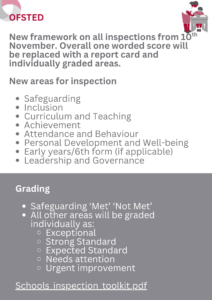The new Ofsted Framework is now active, and we are aware of schools already getting the calls and undergoing inspections. Ofsted has set out a renewed approach to education inspection that will give parents better and more detailed information, is fairer on professionals, and – crucially – will help raise standards for all children.
We wish all our clients getting the call, the very best of luck.
So, what are the main changes?
A new Education Inspection Framework
This framework will change both what is inspected, and how establishments are graded. There will be a focus on pupil wellbeing, inclusion, attendance, and safeguarding. There will also be a focus on how schools create a culture to enable pupils to thrive, over the previous academic outcomes.
The single grading will be replaced by a five point grading scale and report card system to give a more rounded picture.
Pupil wellbeing must be embedded into everyday practice.
Recent reports suggest one in five pupils struggle with mental health. Absence figures continue to climb for various reasons and schools are still tackling challenges as a result of Covid. The new Ofsted framework builds on the idea that human connection, relationships and wellbeing should be ongoing and part of everyday school life.
Areas to be evaluated
There are 8 areas that will be evaluated and individually graded during inspection.
- Safeguarding (This is slightly different to the other areas and will be graded either MET or NOT MET
- Inclusion
- Curriculum and Teaching
- Achievement
- Attendance and Behaviour
- Personal Development and Wellbeing
- Early Years/6th Form (If applicable)
- Leadership and Governance
How will the grading look?
There will no longer be an overall effectiveness grade. Instead there will be a five point scale to grade.
The evaluation scale for each evaluation area, other than safeguarding, is:
Exceptional (highest quality provision): an evaluation area can be graded ‘exceptional’ when all the strong standards have been met and if it meets all the additional standards in the ‘exceptional’ section of the toolkit.
Strong standard: an evaluation area can be graded ‘strong standard’ when all the expected standards and all the strong standards have been met.
Expected standard: an evaluation area can be graded ‘expected standard’ when all the standards are met – this includes meeting the legal requirements and the expectations set out in statutory guidance, as well as the professional standards required of the particular type of provision, where these apply.
Needs attention: an evaluation area can be graded ‘needs attention’ when the ‘expected standard’ has not been met because some aspects of provision are inconsistent, limited in scope or impact and/or not fully meeting the legal requirements.
Urgent improvement (lowest quality provision): an evaluation area can be graded ‘urgent improvement’ when it needs urgent action to provide a suitable standard of education and/or care for children and learners.

More information and further support
More information on the new EIF can be found at
Education inspection framework: for use from November 2025 – GOV.UK
There are toolkits available which provide a more in-depth insight into the areas to be graded.
School inspection: toolkit, operating guide and information – GOV.UK
Ofsted is a pressured time for a full school team. Additional support can be accesses via Education Support.
Emotional and practical support for teachers and education staff

